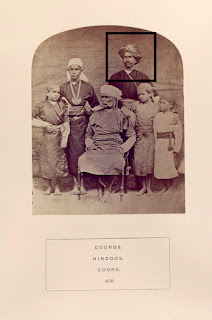Thanks Deccan Herald.
Photo courtesy : Ashoka Biddappa Muckatira (Newspaper edition), John Napier
In the spirit of worship,
MOOKONDA KUSHALAPPA,
NOV 27 2017, 21:50 IST, Deccan Herald,
NOV 27 2017, 21:50 IST, Deccan Herald,
The worship of spirit deities is prevalent in Dakshina Kannada, Udupi and Kodagu districts of Karnataka. The spirit worship ceremony, performed annually in the village temples and ancestral households, is called theray in the Kodava language. A traditional dancer dons face paint or mask and the costume, often red coloured, of a deity, and prances around. Later, he behaves as a medium of the spirit of the deity and advises the devotees as they come to him with their problems.
The Vishnu Murthy shrine
The Vishnu Murthy shrine, located near the Choli Povvadiamme Bhagawathy Temple in Arapattu village, has one such ceremony where spirit deities are worshipped. It is generally called Choundi theray, although Choundi (also Chamundi or Chavundi) is not the only deity propitiated here. The Choundi theray takes place after the Bhagwathy temple festival.
The deity in this temple is said to be in the form of Narasimha, an avatar of Lord Vishnu. Upon the gable of this red-tiled shrine is the face of a moustached deity, its face painted in yellow colour. Near the base and on either side of the entrance is the face of a lion.
The deity of this shrine is offered non-vegetarian food. The Brahmin priest of the nearby Bhagawathy Temple and his family visit the temple to seek blessings. The local Muslims, called mappilla, also pay obeisance here. The priest of this shrine traditionally belongs to the Maleya community. The Maleyas travel to nearby villages during the theray season to perform and help in the arrangements.They wear a saffron panche during the preparations. The Banna and the Panika are other communities who perform such ceremonies in parts of Kodagu. Bhadrakali worship is conducted by the Panikas.
The Maleyas come from the villages of Kirundad, Marandod and Parane for the Arapattu ceremony. The theray begins with the opening performance of a spirit deity called Thota, at night, and it is followed by performances of the Anji Koot Murthy, the five spirits. They are Kutti Chatta, Kari Baala, Kala Bhairava, Kuliya and Nuchchute. The Choudi and Vishnu Murthy performances happen the next morning.
Anji Koot Murthy theray
I visited Arapattu in the theray season. The village stalls were set up, they sold food items and other goods. The preparation for the theray began in the evening, in the adjacent threshing ground. A shelter for the performers to rest was placed beside the ground. The performance started after dinner. The preparation for the performance began with the nooth kuripo (face paint) and alankara (dressing the performer) began. The performers were dressed in red. A thoodu (bamboo torch) was carried along by one of the people accompanying the performers.
The first performer arrived from the threshing ground in the guise of a Thota. As part of the act, he kept turning his head to look behind him every now and then. Then, he pranced around for a while in front of the shrine and then went to the shrine and seated himself on a stool before the inner sanctum. Devotees came to him with their prayers. He listened to them and answered. Later, the Thota was carried out of the shrine by another performer.
Similarly, the other performers came to the temple. Kutti Chatta held a stick and a bell, and had decorative eyes. His eyes were covered with large shells with holes in the middle. Bhairava, on the other hand, didn't have such eye coverings. Kari Baala, a fierce avatar, held two swords. In the middle of his performance, he took the musicians to task for not playing vigorously enough and demanded that the devotees also dance along with him. Nuchchute, the last of the five, walked comically and made the people laugh. Supposedly a female deity, the performer wore grass upon his head. He went from person to person and whispered into their ears as they gave him money.
A different enactment called the Thirale was performed after the five performances. The performer was subjected to mystic experiences. He performed a frantic trembling dance dressed in white kuppya chele(a traditional costume) as he held a staff and an oide-katti, a billhook shaped war knife. He took turns performing as Bhagawathy and Vishnu Murthy throughout the night.
Choundi theray
Next morning, the Choundi and Vishnu Murthy performances were enacted. There were six chenda drummers. There was another drummer and one gong player as well, both belonging to the Meda community and the elderly drummer was dressed in white kuppya chele. The Choundi performer wore a hay skirt and walked around what remained of the bonfire, that was lit by the villagers at night. He was held by both hands as he was thrown on the smouldering bonfire and then dragged away from it a number of times.
The Thota performer gave the Vishnu Murthy performance as well. He wore a steel mask, which depicted a moustached face, and a hay skirt. His legs were plastered with mud. He performed first at the Vishnu Murthy shrine and then at the Bhagawathy shrine. In the evening a non-vegetarian feast called bharani was served to the families of the village.
 | |
|
http://www.deccanherald.com/content/645061/in-spirit-worship.html
Text by yours truly, M P Nitin Kushalappa (Mookonda Kushalappa);







